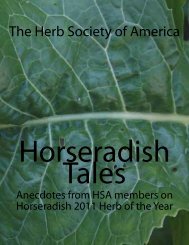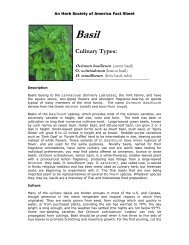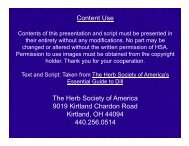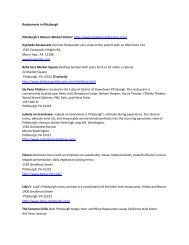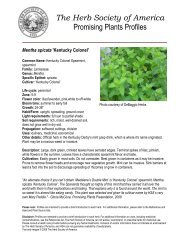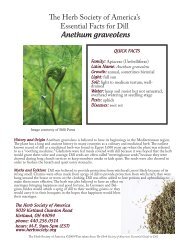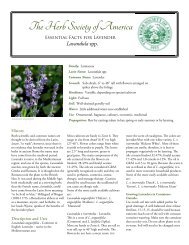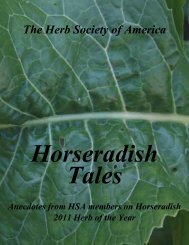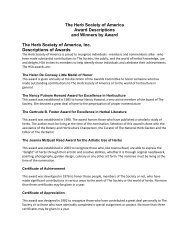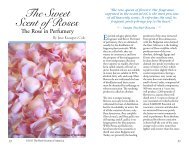HSA - Fact Sheet 1- parsley - The Herb Society of America
HSA - Fact Sheet 1- parsley - The Herb Society of America
HSA - Fact Sheet 1- parsley - The Herb Society of America
You also want an ePaper? Increase the reach of your titles
YUMPU automatically turns print PDFs into web optimized ePapers that Google loves.
Essential <strong>Fact</strong>s for Parsley<br />
Petroselinum crispum<br />
Flat leafed <strong>parsley</strong> (Italian)<br />
Family: Apiaceae<br />
Latin Name: Petroselinum crispum<br />
Common Name: Parsley<br />
Growth: Biennial; typically 12 to 15 inches high (reaching 27 to 30 inches when<br />
blooming); about 12 inches wide; flowers tiny, yellow-green in umbels<br />
Hardiness: Withstands frost<br />
Light: Sun to partial shade<br />
Soil: Rich, acidic to basic soil<br />
Water: Reliably moist, but well drained<br />
Use: Culinary; medicinal; cosmetic; ornamental<br />
Propagation: By seed sown in spring<br />
History<br />
<strong>The</strong> three species <strong>of</strong> <strong>parsley</strong> are native to<br />
southeastern Europe and western Asia.<br />
“<strong>The</strong> generic name is derived from the<br />
Greek for rock, petros, which alludes to<br />
its native habitat <strong>of</strong> cliffs, rocks, and old<br />
walls, and selinum, celery; the specific<br />
name refers to the crisped leaves <strong>of</strong> many<br />
cultivars.”1 Parsley is the most widely<br />
cultivated herb in Europe, and the<br />
most-used herb in the United States. It<br />
became popular in Roman times as a<br />
food. “<strong>The</strong>y consumed <strong>parsley</strong> in<br />
quantity and made garlands for banquet<br />
guests to discourage intoxication and to<br />
counter strong odors.”2 It gained favor<br />
as an attractive plant that could be used<br />
as an edging in the garden or grown in a<br />
container. <strong>The</strong> Greeks held <strong>parsley</strong> in<br />
high esteem and used it to crown victors<br />
at the Isthmian Games. <strong>The</strong>y also used<br />
it medicinally, and Homer notes that<br />
they fed it to their horses. <strong>The</strong> root<br />
variety (the roots are said to be about six<br />
times the size <strong>of</strong> regular <strong>parsley</strong>) has been<br />
grown since the 16th century, but<br />
remains a small scale crop.<br />
Description<br />
Parsley is a biennial herb with bright<br />
green, fern-like leaves on stems that<br />
grow up from a central crown. <strong>The</strong><br />
typical height <strong>of</strong> <strong>parsley</strong> is 12 to 15<br />
inches. When it produces bloom and<br />
seed-producing stems it can reach a<br />
height <strong>of</strong> 27 to 30 inches. <strong>The</strong> typical<br />
spread <strong>of</strong> the plant is about 12 inches.<br />
<strong>The</strong> leaf stems have a stronger flavor<br />
than the leaf. <strong>The</strong> leaves provide a fresh<br />
taste and are high in nutrients. <strong>The</strong>y<br />
contain vitamins A, B, and C and the<br />
minerals iron, calcium, and magnesium.<br />
<strong>The</strong> presence <strong>of</strong> high amounts <strong>of</strong><br />
chlorophyll gives it antiseptic qualities.<br />
<strong>The</strong>re are three types <strong>of</strong> Petroselinum<br />
crispum grown in the U.S.:<br />
P. c. var. crispum - Curled-leaf <strong>parsley</strong>.<br />
<strong>The</strong> leaves are bright green, finely cut<br />
with a toothed leaf margin.<br />
P. c. var. neapolitanum – Flat-leafed<br />
(Italian) <strong>parsley</strong>. <strong>The</strong> leaves are flat, less<br />
finely cut, and dark green, with a<br />
stronger flavor than P. c. var. crispum.<br />
Flat-leafed <strong>parsley</strong> is generally hardier<br />
than the curled-leaf.<br />
P. c. var. tuberosum – Turnip-rooted <strong>parsley</strong>.<br />
This <strong>parsley</strong> has flat leaves, but is grown for<br />
its large, edible root which is prepared as a<br />
vegetable.<br />
Many cultivars exist <strong>of</strong> both the curled-leaf,<br />
and flat-leaf types. Each cook/gardener will<br />
need to determine what is available at their<br />
local nursery, and which one best suits their<br />
particular palette.<br />
Culture & Propagation<br />
Parsley likes bright light, but not<br />
necessarily full sun. It will grow well in<br />
partially shaded gardens.<br />
Sow seed (soaked in water, changed daily,<br />
up to three days before planting) in the<br />
spring. Parsley grows best with bright light<br />
in a rich, well drained soil. Seeds can be<br />
sown from spring to late summer. After<br />
planting, keep the seed well watered. If the<br />
soil and seed dry out, it will not germinate.<br />
It is best to thin the young plants to about<br />
nine inches apart. When cold weather<br />
comes, if plants can be protected, they will
continue to supply your needs for fresh <strong>parsley</strong>. In cold<br />
climates <strong>parsley</strong> will provide a continuous crop if planted in<br />
a cold frame. Parsley can also be grown in a pot on a<br />
windowsill in the winter. <strong>The</strong> more you clip it, the more it<br />
will grow.<br />
During the first year <strong>of</strong> growth, if flower stalks appear cut<br />
them out to prevent the plant from going to seed. <strong>The</strong><br />
leaves will retain a better flavor. It is also recommended<br />
that new plants be started each year for the best flavor.<br />
Uses<br />
Culinary:<br />
Leaves can be added raw to salads, or sprinkled onto a<br />
sandwich. It is good in salad dressings, sprinkled over fish<br />
just before serving, or added to tomato, potato or egg<br />
dishes. It is used in the preparation <strong>of</strong> meats, stuffings,<br />
soups and stews and as a garnish.<br />
Parsley serves as a flavor enhancer when cooked. It is best<br />
if added towards the end <strong>of</strong> the cooking time. Root<br />
<strong>parsley</strong> can be grated raw into a salad, added to soups or<br />
stews or cooked and served as a root vegetable. Mix leaf<br />
<strong>parsley</strong> with other herbs into butter to create herb butter.<br />
Parsley is one <strong>of</strong> the herbs in “fines herbes”, along with<br />
chervil, chives, and tarragon.<br />
Parsley is best used for flavoring during its first year. <strong>The</strong><br />
second year is a seed-producing year and the leaves tend to<br />
take on a bitter flavor.<br />
Companion Plant:<br />
Parsley grown with roses is said to improve their scent and<br />
keep them healthier. It is also a good companion for<br />
tomato plants and attracts honeybees when in bloom.<br />
Cosmetic:<br />
Leaves infused in water make a good hair tonic and<br />
conditioner or can be added to body lotion for dry skin.<br />
Medicinal:<br />
Eating <strong>parsley</strong> leaves serves as a good breath freshener. A<br />
digestive tonic can be made by infusing leaves. Parsley tea<br />
improves circulation. Root decoctions can be used to treat<br />
kidney ailments, or as a mild laxative.<br />
Topically, leaves can be used in a poultice as an antiseptic<br />
dressing for wounds, bites and stings. Also, applying juice<br />
from the roots will reduce swelling.<br />
Note:<br />
Caution must be exercised when using Petroselinum<br />
infusions or decoctions internally. High concentrations<br />
may cause inflammation, abortion, or damage to the<br />
digestive or urinary systems.<br />
Harvesting<br />
Sources<br />
Curled leaf <strong>parsley</strong><br />
Parsley is best when harvested and used fresh. Cut the leaves and use<br />
them either whole or chopped, depending on the dish. If you want a<br />
stronger flavor also use the stems (they have more flavor) with the leaves.<br />
Parsley can be dried and stored in the dark (to retain color) in an airtight<br />
container for later use, or it can be placed in the freezer (chopped and<br />
put into water in ice cube trays, or wrapped in foil and placed in a<br />
zip-lock bag), pulled out, and used as needed. Freezing maintains its<br />
freshness for later usage.<br />
Plant Information Online is a source to links to North <strong>America</strong>n seed<br />
and nursery firms. It is a free service <strong>of</strong> the University <strong>of</strong> Minnesota<br />
Libraries. http://plantinfo.umn.edu<br />
1)Tucker, Arthur O., Ph.D., and Thomas DeBaggio. 2009.<br />
<strong>The</strong> encyclopedia <strong>of</strong> herbs. Timber Press. Portland, Oregon. Pg. 393-394.<br />
2)Bremness, Lesley. 1998. <strong>The</strong> complete book <strong>of</strong> herbs.<br />
Dorling Kindersley. London. Pg. 108<br />
Additional References<br />
Bown, Deni. Encyclopedia <strong>of</strong> <strong>Herb</strong>s and <strong>The</strong>ir Uses.<br />
Dorling Kindersley. London, 1995.<br />
Parsley root<br />
Grieve, Mrs. M. A Modern <strong>Herb</strong>al.<br />
Dorset Press (first published in 1931). New York, 1992.<br />
Hemphill, John and Rosemary.<br />
<strong>Herb</strong>s <strong>The</strong>ir Cultivation and Usage. Blandford Press. Dorsett, 1984.<br />
Schlosser, Katherine. Essential Guide to Growing and Cooking with <strong>Herb</strong>s.<br />
Louisiana State University Press. Baton Rouge, Louisiana, 2007.<br />
Tucker, Arthur O.,Ph.D., and Thomas DeBaggio.<br />
<strong>The</strong> Big Book <strong>of</strong> <strong>Herb</strong>s. Interweave Press. Colorado, 2000.<br />
Medicinal Disclaimer - It is the policy <strong>of</strong> <strong>The</strong> <strong>Herb</strong> <strong>Society</strong> <strong>of</strong> <strong>America</strong> not to advise or recommend herbs for medicinal or health use. This information is intended for<br />
educational purposes only and should not be considered as a recommendation or an endorsement <strong>of</strong> any particular medical or health treatment.<br />
9019 Kirtland Chardon Rd. Kirtland, Ohio 44094 440.256.0514, herbs@herbsociety.org<br />
©2012 <strong>The</strong> <strong>Herb</strong> <strong>Society</strong> <strong>of</strong> <strong>America</strong>/Text by Joyce E. Brobst




